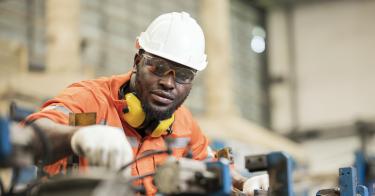Only on the internet is 25% of people considered “nobody.”
A poll from the Cato Institute recently set social media abuzz. About 80% of the poll’s respondents said that the country would be better off if more people worked in manufacturing, but only 25% said they themselves would be better off working in a factory instead of their current job.
The common reaction online was to assume that people weren’t willing to put their money where their mouth is: sure, everyone wants American manufacturing to grow, but no one wants to work in a factory. Those pining for a return of American industry were once again tilting after windmills. But the critics should have run the actual math. That level of interest in factory jobs is enormous—enough to double current employment in manufacturing.
Currently, the manufacturing sector employs about 12.7 million workers; that’s out of a total U.S. employment of 163 million. Cato only asked its survey question to people who are not retired or currently employed in manufacturing. If 25% of that group wants to move to factory jobs, then that translates to 37.6 million potential new manufacturing workers, significantly more than the 449,000 current openings. Just a 60% increase in manufacturing employment would still yield more than 20 million workers, above the all-time high.
If so many people are willing to work in factories, why aren’t more factories hiring? What’s standing in the way of matching willing workers with the jobs they want? And what would it take to create more jobs in American manufacturing?
>>> End the War on Manufacturing: An Agenda to Restore Industrial Production in the United States
When people imagine factory work, they typically picture jobs classified as “production occupations.” The Bureau of Labor Statistics defines these occupations as workers who “operate machines and other equipment to assemble goods or distribute energy.” Production workers comprise almost half of workers in the manufacturing sector, and just over 70% of them are employed by manufacturing firms. The median annual wage for production workers is $45,960, just below the median of $49,500 for all occupations.
However, production jobs may be desirable because entry-level positions often pay well relative to those in other occupations. Though the median wage is below the overall median, the 10th and 25th percentiles for production occupations are higher. For example, someone starting out as a forklift operator in a warehouse may be paid more than a school janitor or a food prep worker at a hospital cafeteria. Many entry-level positions require only a high school degree or the equivalent, making those careers a good fit for people who don’t want to or can’t attend college.
The median pay in production occupations exceeds that of occupations in transportation, sales, healthcare support, cleaning and maintenance, farming, personal care, and food preparation. Collectively, those occupations employ about 36% of workers, so it’s entirely plausible that 25% of non-manufacturing workers would see a pay increase by moving to a factory.
But despite that substantial interest, several obstacles are holding would-be factory workers back from making the leap.
For one, they may not have the right skills. About half of the manufacturing positions expected to open over the next decade may go unfilled because workers don’t have the right skills. As manufacturing becomes more technical and specialized, workers need more high-tech skills tied to robotics, computer-assisted design, or 3-D printing. For laid-off workers who need to adapt later in their careers, learning these new skills offers a lower return on investment that may keep them searching for jobs that no longer exist.
Location is another major factor preventing workers from switching to factory jobs. Recently, the states losing manufacturing jobs are in the Midwest and Northeast, while the states gaining jobs are in the South and West. This is consistent with the pattern of domestic migration, which shows people moving to states with better business environments and lower taxes.
Shifts in the location of manufacturing work and increased automation are two leading factors behind the decline of domestic manufacturing employment. Yet, factories closing and shifting production to locations with lower labor costs isn’t necessarily a problem if the lost jobs are replaced with higher-value jobs. However, opening up new factories in the United States has grown more difficult over time—often as a result of regulatory decisions that have amplified manufacturing’s decline.
Across the economy, business entry and exit rates have been declining for decades. While the manufacturing exit rate has fallen only slightly, the entry rate has dropped faster and more persistently. Since the early 1980s, the establishment exit rate for manufacturing has been about 2% slower than the overall rate, but the entry rate has been about 4% slower. This means that when plants close, they often go unreplaced—a fact that’s particularly devastating for small towns where a factory often serves as a cornerstone employer.
One of the biggest reasons for this slowdown in opening new establishments is the high cost of regulation. Overall, regulation has nearly doubled since manufacturing employment peaked in 1979. And manufacturing firms in particular bear higher costs from regulation.
Across all businesses in 2023, the average regulatory cost per employee was $12,800, of which $2,800 was environmental. But the problem is even more acute for manufacturing firms, where the average regulatory cost per employee was $29,100, of which $17,200 was environmental. These costs are expenses that could otherwise go toward higher wages or lower product costs.
Among manufacturing firms themselves, compliance costs particularly affect small firms. For small manufacturing firms, the average regulatory cost per employee was $50,100, of which $40,700 was environmental. Large firms face lower costs per employee because they can spread fixed compliance costs over a larger number of employees.
The high cost for small firms compounds the economic effects of regulation by acting as a protective barrier for incumbent large firms. The harder it is for small firms to grow, the fewer firms survive to be major employers.
All these challenges confronting what workers want and what America needs raises a natural question: What policy changes are necessary to create more manufacturing jobs for the 25% who want them?
One high-profile approach from the Trump administration has been a set of tariffs on imported goods. According to Stephen Miran, the chair of the Council of Economic Advisers, demand for the dollar and Treasury debt has driven up exchange rates and made imports unduly cheap. By making imports more expensive, he suggests, tariffs would encourage a shift toward domestic production.
President Trump’s instinct—when you tax something, you get less of it—is directionally correct. Tax imports from China, for example, and the United States will import less from China. However, taxing imports alone doesn’t guarantee that factories will open in the United States. After all, the ultimate competition isn’t simply with foreign factories, but with economic inactivity—the failure to invest and build at home. And the barriers to do so are high. If we want more manufacturing in the United States, then we need more investment. To create this, we have to change the conditions through a mix of carrots and sticks—not just taxing imports but also lowering taxes and the costs of production at home.
With today’s global supply chains, simply taxing imports risks unintended consequences. Following Trump’s announcement of new tariffs, YouTuber and entrepreneur MrBeast posted that tariffs make it cheaper for his candy company, which currently produces some of its products in the United States, to manufacture chocolate bars entirely outside the United States. Chocolate production can’t easily move to the United States, so the current tariffs instead incentivizes producers to move to the other side of the tariff wall to reach a global market less expensively.
These kinds of consequences highlight why the policy mix should focus on carrots. We need to cut away the compliance costs that discourage firms from building factories in America. Our economy should reward people for starting business and hiring workers, not simply reward those who can best navigate regulatory systems.
To keep the emphasis on more investment and rising wages, automation should be embraced, not feared. It lets machines do work suited for machines, while humans do work suited for humans. The jobs most subject to automation require well-defined repetitive tasks. Both repetitive cognitive tasks, such as filing paperwork in an office, and repetitive manual tasks, such as moving boxes in a warehouse, were subject to replacement through automation. Job growth remains positive in non-repetitive tasks that require creativity and problem-solving skills. While automation may eliminate some jobs, it will also create new ones, transforming the nature of work rather than reducing the aggregate amount.
Schools must adapt by preparing students for highly automated workplaces and offering opportunities for mid-career upskilling. This would help equip those would-be factory workers with the hard skills needed for America’s new industrial demands. Workers who can harness the newest technologies will be more productive and will earn higher wages.
>>> Cracking Down on Illegal Immigration Would Raise Wages for Lower-Income Americans
Manufacturing is likely to change, and that points toward fewer massive factories and more small firms. The higher regulatory costs and lower productivity suggest that small businesses have the most to gain from deregulation. As AI and automation decrease in cost, small firms will be able to produce almost as efficiently as larger firms. Customization, rapid prototyping, and on-demand production will place a premium on relationship between designers and manufacturers who can take advantage of a reshoring trend that’s already underway. Rural towns in particular should welcome the potential new economic expansions, particularly with a shift to smaller firms so that they are protected from the risk of a cornerstone employer going out of business and leaving the population without regular work.
The benefits of a deeper pool of labor and smaller firms will compound if manufacturing industries concentrate in regional hubs. One novel approach to support this is the use of training programs, which can reach more would-be factory workers with the education they need for today’s modern factory work at a lower cost by concentrating in a single geographical area. Workers can move between firms without having to uproot their families from their communities. And knowledge spillovers could raise productivity through workers in related industries exchanging information.
Critics may dismiss pro-manufacturing policies as driven by nostalgia, but that misunderstands what modern factory work actually looks like. The labor-intensive jobs of the mid-20th century are not coming back because economic conditions have changed. Since World War II, the rest of the world has rebuilt and many emerging economies have industrialized, making global competitors far closer to the United States in capability and cost than in the past. Today’s American manufacturing relies on advanced machinery, digital supply chains, and highly skilled workers. The right strategy is to double down on America’s strengths, particularly in capital-intensive, high-value manufacturing. Policy should focus on removing frictions, like skill mismatches or relocation barriers, that keep workers from filling modern manufacturing jobs where the United States retains a comparative advantage.
The decline of American manufacturing employment isn’t inevitable. Despite the online reaction, that Cato poll reveals that a significant share of Americans want to work in the sector. The Trump administration has already signaled its focus on reindustrialization. With the right mix of deregulation and permitting reform, we can help American businesses expand production—enabling workers to find the meaningful jobs they’re ready to take.
This piece originally appeared in Commonplace





